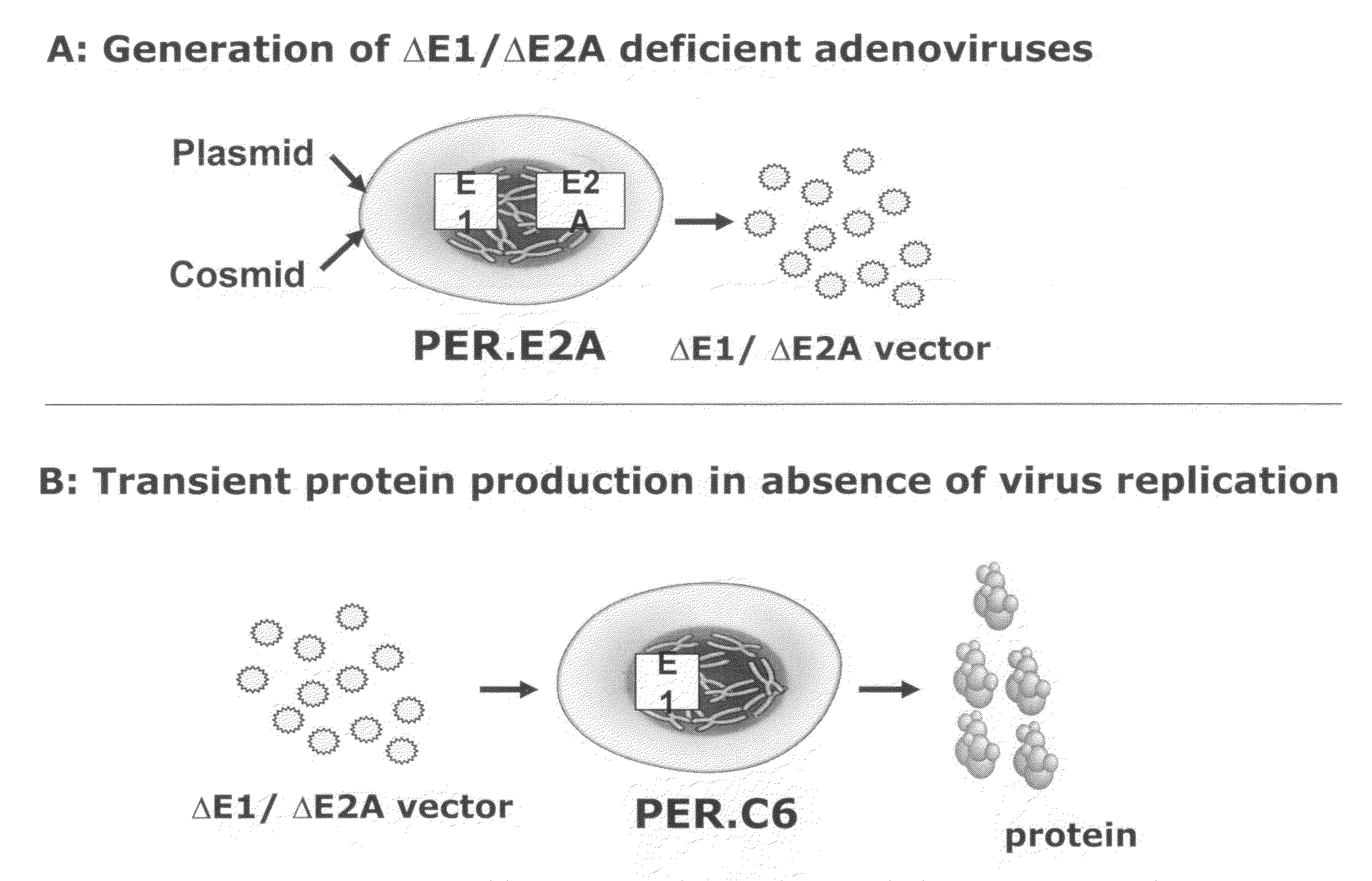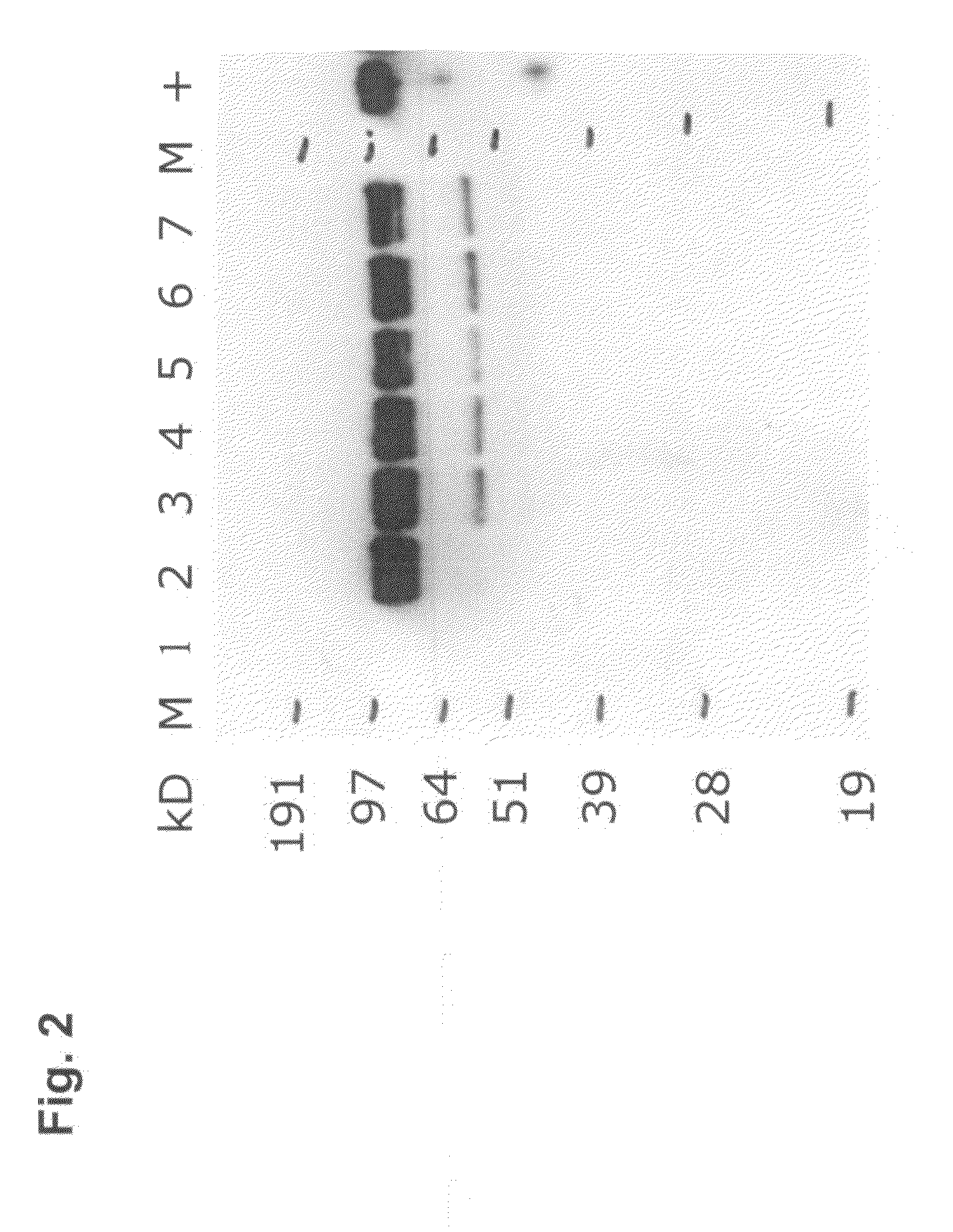Transient protein expression methods
a technology of transient protein and expression method, which is applied in the field of biotechnology and recombinant protein production, can solve the problems of high undesired presence of adenoviral structural protein in the preparation of produced protein, and achieve the effect of reducing the number of transient protein expression methods
- Summary
- Abstract
- Description
- Claims
- Application Information
AI Technical Summary
Benefits of technology
Problems solved by technology
Method used
Image
Examples
example 1
Construction of Basic Expression Vectors
[0126]Plasmid pcDNA3.1 / Hygro(−) (Invitrogen) was digested with NruI and EcoRV, dephosphorylated at the 5′ termini by Shrimp Alkaline Phosphatase (SAP, GIBCO Life Tech.) and the plasmid fragment lacking the immediate early enhancer and promoter from CMV was purified from gel. Plasmid pAdApt (Crucell N V of Leiden, N L), containing the full length CMV enhancer / promoter (−735 to +95) next to overlapping Adeno-derived sequences to produce recombinant adenovirus, was digested with AvrII, filled in with Klenow polymerase and digested with HpaI; the fragment containing the CMV enhancer and promoter was purified over agarose gel. This CMV enhancer and promoter fragment was ligated bluntiblunt to the NruI / EcoRV fragment from pcDNA3.1 / Hygro(−). The resulting plasmid was designated pcDNA2000 / Hyg(−).
[0127]Plasmid pcDNA2000 / Hyg(−) was digested with PmlI, and the linearized plasmid lacking the Hygromycin resistance marker gene was purified from gel and reli...
example 2
Construction of EPO Expression Vectors
[0131]The full length human EPO cDNA was cloned, employing oligonucleotide primers EPO-START: 5′ AAA AAG GAT CCG CCA CCA TGG GGG TGC ACG AAT GTC CTG CCT G-3′ (SEQ ID NO:5) corresponding to the incorporated '007 application and EPO-STOP: 5′-AAA AAG GAT CCT CAT CTG TCC CCT GTC CTG CAG GCC TC-3′ (SEQ ID NO:6) corresponding to the incorporated '007 application (Cambridge Bioscience Ltd.) in a PCR on a human adult liver cDNA library. The amplified fragment was cloned into pUC18 linearized with BamHI. Sequence was checked by double stranded sequencing. This plasmid containing the EPO cDNA in pUC18 was digested with BamHI and the EPO insert was purified from agarose gel. Plasmids pcDNA2000 / DHFRwt and pcDNA2000 / DHFRm were linearized with BamHI and dephosphorylated at the 5′ overhang by SAP, and the plasmids were purified from agarose gel. The EPO cDNA fragment was ligated into the BamHI sites of pcDNA2000 / DHFRwt and pcDNA2000 / DHFRm; the resulting plasmi...
example 3
Construction of UBS-54 Expression Vectors
[0139]The constant domains (CH1, -2 and -3) of the heavy chain of the human immunoglobulin G1 (IgG1) gene including intron sequences and connecting (“Hinge”) domain were generated by PCR using an upstream and a down stream primer. The sequence of the upstream primer (CAMH-UP) is 5′-GAT CGA TAT CGC TAG CAC CAA GGG CCC ATC GGT C-3′ (SEQ ID NO: 18) corresponding to the incorporated '007 application, in which the annealing nucleotides are depicted in italics and two sequential restriction enzyme recognition sites (EcoRV and NheI) are underlined.
[0140]The sequence of the down stream primer (CAMH-DOWN) is: 5′-GAT CGT TTA AAC TCA TTT ACC CGG AGA CAG-3′ (SEQ ID NO:19) corresponding to the incorporated '007 application, in which the annealing nucleotides are depicted in italics and the introduced PmeI restriction enzyme recognition site is underlined.
[0141]The order in which the domains of the human IgG1 heavy chain were arranged is as follows: CH1-in...
PUM
| Property | Measurement | Unit |
|---|---|---|
| temperatures | aaaaa | aaaaa |
| temperatures | aaaaa | aaaaa |
| temperature | aaaaa | aaaaa |
Abstract
Description
Claims
Application Information
 Login to View More
Login to View More - R&D
- Intellectual Property
- Life Sciences
- Materials
- Tech Scout
- Unparalleled Data Quality
- Higher Quality Content
- 60% Fewer Hallucinations
Browse by: Latest US Patents, China's latest patents, Technical Efficacy Thesaurus, Application Domain, Technology Topic, Popular Technical Reports.
© 2025 PatSnap. All rights reserved.Legal|Privacy policy|Modern Slavery Act Transparency Statement|Sitemap|About US| Contact US: help@patsnap.com



